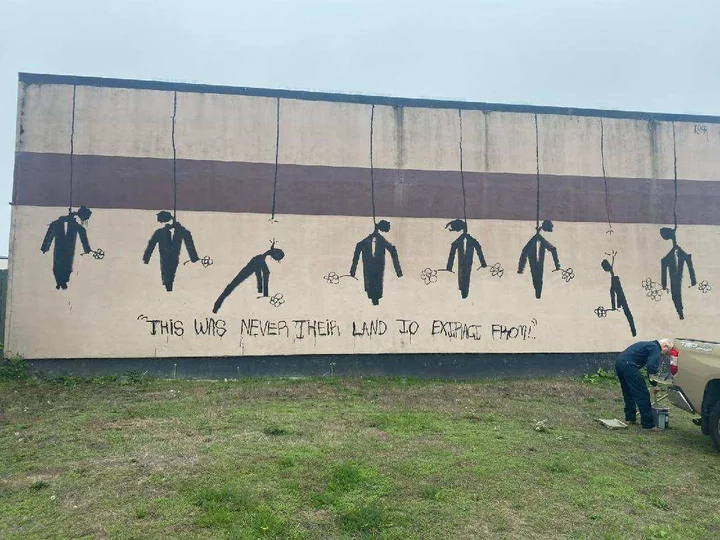Photo: EPD.
###
PREVIOUSLY:
- Someone Painted an Image of a Hanged Man Holding a Flower All Over Eureka and Arcata; Police Investigating
- POLL! What is the Meaning of This ‘Art’?
###
Press release for Humboldt Showing Up for Racial Justice and the Ink People:
Humboldt Showing Up for Racial Justice (SURJ), the Ink People Center for Arts and Culture, Black community leaders, and elected officials condemn a series of stenciled images discovered on September 18 and 19 in Eureka and Arcata depicting a hanged person, some accompanied by the words “Don’t be the next.” These images — discovered by Black community members on September 19, after a week of escalating racialized violence and speech across the nation, including the alleged lynching of a Black student in Mississippi — evoke the history of lynching in the United States and are widely understood as messages meant to intimidate and instill fear in Black communities.
Why this matters
A known symbol of racial intimidation. Noose/lynching imagery in public spaces is historically tied to racial terror and modern hate intimidation. Cultural and civil-rights institutions have repeatedly documented its use as a threat (Smithsonian Magazine).
The current climate. The U.S. Department of Justice reports that anti-Black incidents constitute a majority of race-based hate-crime incidents nationally (2023), and agencies recorded 11,679 incidents in 2024 (Department of Justice).
California context. California’s Attorney General reports anti-Black bias remains the most prevalent race-based motivation in the state’s hate-crime data (California Department of Justice).
Applicable law. California Penal Code §11411 prohibits displaying terrorizing symbols (including nooses) at homes, workplaces, schools, or public places with the purpose — or reckless disregard — of terrorizing others.
In this period of growing unrest, these images have caused concern in the local community, striking fear and grief among those whose ancestors and families have experienced the long history of racial violence and terrorism in this country. Nearly 5,000 lynchings occurred in the U.S. from 1882 to 1968, though the actual number is likely higher due to underreporting. Lynching was also a tool of white supremacy used against Latinos and Indigenous peoples in California. While lynchings aren’t as frequent today, lynchings and references to lynchings continue to be tools of white supremacy and racial terrorism inflicted on Black communities.
Local Black community members have expressed the terror and distress they have felt since seeing these images in our communities’ business and arts districts — including on the building of at least one Black-owned business. One local Black community member, who wished to remain anonymous for their own safety, shared:
“It’s the reality — the harm was done, the fear was stoked in people. Sometimes carelessness causes real palpable harm. And I understand why people don’t necessarily believe what’s being said. It’s hard to imagine anyone claiming to stand for the message that is supposedly being intended would be so careless as to use imagery synonymous with the murder of Black folks while we are actively being lynched all over the country in the last week. Who in their right mind would even do that? How much privilege do you have to carry to not understand how that image will inevitably be interpreted?”
The pairing of lynching imagery with “Don’t be the next” is reasonably perceived by Black residents as a direct threat. In a national environment where documented hate-crime levels remain high, incidents like these heighten fear, retraumatize communities, and chill participation in public life. As community members and leaders here in Humboldt County — where extreme episodes of racial terror and violence have taken place — we collectively condemn the use of racist imagery, regardless of the intent of the message behind it. Using an image of a hanged person at any time causes harm and instills fear in local Black community members, and the use of it in the current political climate is ignorant and indifferent to the very real harms that Black people in particular continue to experience with racist violence. These recent acts demonstrate that, at best, we have a lot of learning and work ahead of us to fight ignorance and racial violence.
Against this backdrop, public displays invoking lynching — paired with the phrase “Don’t be the next” — do not read as “mere graffiti.” They echo historic mechanisms of racial terror, and for many Black residents and other communities of color, they function as threats aimed at silencing, isolating, and driving people out of public space.
This is a moment of community action and learning
The coalition calls for continued investment in:
Take action: We have a collective community responsibility to one another to resist racial ignorance and violence and take action in support of the safety and belonging of our Black, Indigenous, and People of Color friends, families, neighbors, and colleagues. We invite you to take tangible action today. Some ways you can do this are:
- Education & prevention on the history and present realities of racialized violence.
- Visible solidarity. Public agencies, schools, businesses, and civic groups should affirm that Black residents belong and are safe here — and back those words with action.
- Reporting & support. If you see similar graffiti or have information, report it immediately.
- Meet your neighbors and look out for each other.
- Learn more about the history of lynching in this country and state (link).
- Join and support the Eureka chapter of the NAACP (link).
- Learn more and take action on issues of racial and economic justice with Humboldt SURJ (Showing Up for Racial Justice) (link)

CLICK TO MANAGE